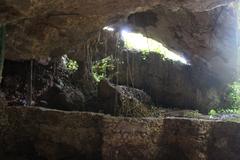Cenote X-Kekén in Valladolid: Visiting Hours, Tickets, and Historical Significance
Publication Date: 19/07/2024
Introduction
Table of Contents
- [Introduction](#introductionintroduction)
- [History and Cultural Significance](#history-and-cultural-significancehistory-and-cultural-significance)
- [The Maya and the Sacred Cenotes](#the-maya-and-the-sacred-cenotesthe-maya-and-the-sacred-cenotes)
- [X-Kekén - A Place of Ritual and Offerings](#x-kekén---a-place-of-ritual-and-offeringsx-kekén---a-place-of-ritual-and-offerings)
- [The Name and its Meaning](#the-name-and-its-meaningthe-name-and-its-meaning)
- [Geological and Environmental Features](#geological-and-environmental-featuresgeological-and-environmental-features)
- [Formation of Cenotes and X-Kekén’s Origins](#formation-of-cenotes-and-x-kekéns-originsformation-of-cenotes-and-x-kekéns-origins)
- [X-Kekén’s Distinctive Features](#x-kekéns-distinctive-featuresx-kekéns-distinctive-features)
- [The Ecosystem of Cenote X-Kekén](#the-ecosystem-of-cenote-x-kekénthe-ecosystem-of-cenote-x-kekén)
- [Visitor Information](#visitor-informationvisitor-information)
- [Visiting Hours and Tickets](#visiting-hours-and-ticketsvisiting-hours-and-tickets)
- [Travel Tips](#travel-tipstravel-tips)
- [Nearby Attractions](#nearby-attractionsnearby-attractions)
- [Environmental Concerns and Conservation Efforts](#environmental-concerns-and-conservation-effortsenvironmental-concerns-and-conservation-efforts)
- [FAQ](#faqfaq)
- [Conclusion](#conclusionconclusion)
History and Cultural Significance
The Maya and the Sacred Cenotes
X-Kekén - A Place of Ritual and Offerings
The Name and its Meaning
Geological and Environmental Features
Formation of Cenotes and X-Kekén’s Origins
The Yucatán Peninsula is essentially a massive platform of limestone, a porous rock highly susceptible to erosion by acidic rainwater. Over time, rainwater seeps through the limestone, dissolving it and creating a network of underground rivers and caves. When the roof of such a cave collapses, it forms a sinkhole, revealing the water-filled cavern below – a cenote.
X-Kekén’s formation likely occurred in several stages:
- Dissolution of Limestone: Rainwater, slightly acidic due to dissolved carbon dioxide, infiltrated the limestone bedrock, gradually dissolving it and carving out underground cavities.
- Cave Formation: As dissolution continued, these cavities expanded into vast cave systems, often interconnected by underground rivers.
- Roof Collapse: The weight of the overlying rock, coupled with the erosive power of water, eventually caused the cave roof to collapse, creating a large opening to the surface.
X-Kekén’s Distinctive Features
X-Kekén is a semi-open cenote, meaning a portion of its roof remains intact, creating a partially enclosed, cavernous environment. This unique structure allows sunlight to filter through a single opening at the top, illuminating the turquoise waters below in a mesmerizing display of light and shadow.
The cenote’s water is a captivating shade of turquoise, a result of several factors:
- Light Scattering: The water molecules scatter sunlight, with blue wavelengths scattering more effectively.
- Limestone Filtration: The limestone bedrock acts as a natural filter, removing impurities and enhancing the water’s clarity.
- Mineral Content: Dissolved minerals, particularly calcium carbonate, contribute to the water’s distinctive hue.
The Ecosystem of Cenote X-Kekén
Cenotes are not just geological wonders; they are also vibrant ecosystems, home to a surprising array of life adapted to this unique environment.
- Fish: Despite the low light levels, several fish species thrive in X-Kekén’s waters, including catfish, mollies, and even blind cavefish that have adapted to life in perpetual darkness.
- Bats: The cenote’s cavernous interior provides a haven for bats, which play a crucial role in the ecosystem by controlling insect populations and pollinating plants.
- Birds: Various bird species can be observed around the cenote’s opening, attracted by the abundance of insects and the presence of water.
Visitor Information
Visiting Hours and Tickets
Travel Tips
- Accessibility: The cenote is accessible via a short drive from Valladolid. Parking is available on-site.
- What to Bring: Swimsuits, water shoes, and biodegradable sunscreen are recommended. Bringing a waterproof camera can help capture the cenote’s stunning beauty.
Nearby Attractions
While in the area, consider exploring other nearby attractions:
- Valladolid Historical Sites: The charming town of Valladolid offers several historical sites, including the Convent of San Bernardino de Siena and the Casa de los Venados.
- Other Cenotes: Cenote Samulá and Cenote Zací are other beautiful cenotes worth visiting.
Environmental Concerns and Conservation Efforts
The delicate ecosystem of Cenote X-Kekén faces several threats, primarily from human activities:
- Pollution: Runoff from nearby agricultural areas, carrying fertilizers and pesticides, can contaminate the cenote’s water, harming aquatic life.
- Overcrowding: The increasing popularity of cenotes as tourist destinations can lead to overcrowding, putting stress on the environment.
- Vandalism: Unfortunately, some visitors engage in destructive behavior, damaging the delicate formations or littering the site.
To mitigate these threats, local communities and authorities have implemented various conservation measures:
- Water Quality Monitoring: Regular testing of the cenote’s water helps identify and address potential pollution sources.
- Visitor Management: Limiting the number of visitors at any given time helps reduce overcrowding and minimize environmental impact.
FAQ
Common Questions About Cenote X-Kekén
- What is the best time to visit Cenote X-Kekén?
- Early morning or late afternoon to avoid peak hours.
- Are there guided tours available?
- Yes, guided tours can be booked in advance or at the entrance.
- Is Cenote X-Kekén suitable for children?
- Yes, but children should be supervised at all times.
- Can I take photos inside the cenote?
